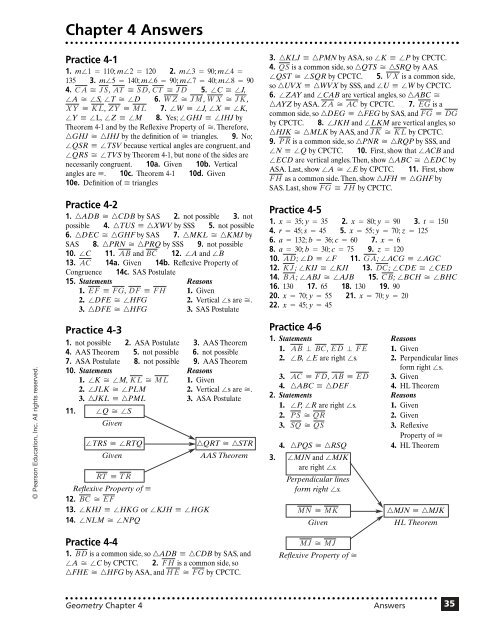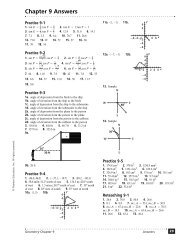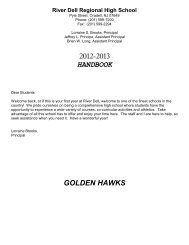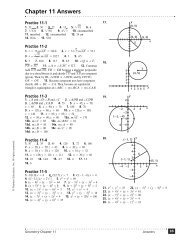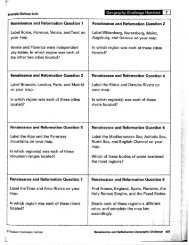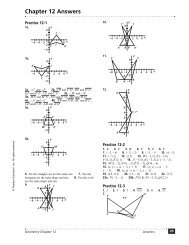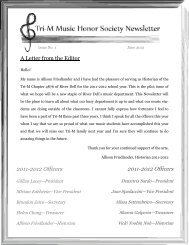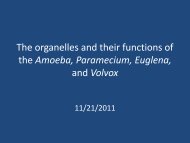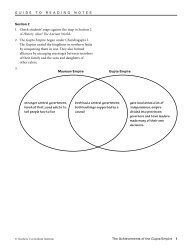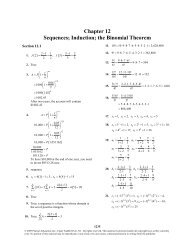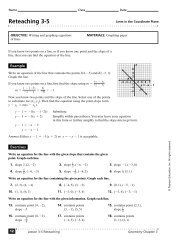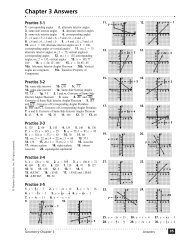chp 4 worksheet answers
chp 4 worksheet answers
chp 4 worksheet answers
Create successful ePaper yourself
Turn your PDF publications into a flip-book with our unique Google optimized e-Paper software.
© Pearson Education, Inc. All rights reserved.<br />
Chapter 4 Answers<br />
Practice 4-1<br />
1. m1 = 110; m2 = 120 2. m3 = 90; m4 =<br />
135 3. m5 = 140; m6 = 90; m7 = 40; m8 = 90<br />
4. CA JS, AT SD, CT JD 5. C J,<br />
A S, T D 6. WZ JM, WX JK,<br />
XY KL, ZY ML 7. W J, X K,<br />
Y L, Z M 8. Yes; GHJ IHJ by<br />
Theorem 4-1 and by the Reflexive Property of .Therefore,<br />
GHJ IHJ by the definition of triangles. 9. No;<br />
QSR TSV because vertical angles are congruent, and<br />
QRS TVS by Theorem 4-1, but none of the sides are<br />
necessarily congruent. 10a. Given 10b. Vertical<br />
angles are . 10c. Theorem 4-1 10d. Given<br />
10e. Definition of triangles<br />
Practice 4-2<br />
1. ADB CDB by SAS 2. not possible 3. not<br />
possible 4. TUS XWV by SSS 5. not possible<br />
6. DEC GHF by SAS 7. MKL KMJ by<br />
SAS 8. PRN PRQ by SSS 9. not possible<br />
10. C 11. AB and BC 12. A and B<br />
13. AC 14a. Given 14b. Reflexive Property of<br />
Congruence 14c. SAS Postulate<br />
15. Statements Reasons<br />
1. EF FG, DF FH 1. Given<br />
2. DFE HFG 2. Vertical s are .<br />
3. DFE HFG 3. SAS Postulate<br />
Practice 4-3<br />
1. not possible 2. ASA Postulate 3. AAS Theorem<br />
4. AAS Theorem 5. not possible 6. not possible<br />
7. ASA Postulate 8. not possible 9. AAS Theorem<br />
10. Statements Reasons<br />
1. K M, KL ML 1. Given<br />
2. JLK PLM 2. Vertical s are .<br />
3. JKL PML 3. ASA Postulate<br />
11. Q S<br />
Given<br />
TRS RTQ<br />
Given<br />
RT TR<br />
Reflexive Property of <br />
12. BC EF<br />
13. KHJ HKG or KJH HGK<br />
14. NLM NPQ<br />
Practice 4-4<br />
QRT STR<br />
AAS Theorem<br />
1. BD is a common side, so ADB CDB by SAS, and<br />
A C by CPCTC. 2. FH is a common side, so<br />
FHE HFG by ASA, and HE FG by CPCTC.<br />
3. KLJ PMN by ASA, so K P by CPCTC.<br />
4. QS is a common side, so QTS SRQ by AAS.<br />
QST SQR by CPCTC. 5. VX is a common side,<br />
so UVX WVX by SSS, and U W by CPCTC.<br />
6. ZAY and CAB are vertical angles, so ABC <br />
AYZ by ASA. ZA AC by CPCTC. 7. EG is a<br />
common side, so DEG FEG by SAS, and FG DG<br />
by CPCTC. 8. JKH and LKM are vertical angles, so<br />
HJK MLK by AAS, and JK KL by CPCTC.<br />
9. PR is a common side, so PNR RQP by SSS, and<br />
N Q by CPCTC. 10. First, show that ACB and<br />
ECD are vertical angles. Then, show ABC EDC by<br />
ASA. Last, show A E by CPCTC. 11. First, show<br />
FH as a common side. Then, show JFH GHF by<br />
SAS. Last, show FG JH by CPCTC.<br />
Practice 4-5<br />
1. x = 35; y = 35 2. x = 80; y = 90 3. t = 150<br />
4. r = 45; s = 45 5. x = 55; y = 70; z = 125<br />
6. a = 132; b = 36; c = 60 7. x = 6<br />
8. a = 30; b = 30; c = 75 9. z = 120<br />
10. AD; D F 11. GA; ACG AGC<br />
12. KJ; KIJ KJI 13. DC; CDE CED<br />
14. BA; ABJ AJB 15. CB; BCH BHC<br />
16. 130 17. 65 18. 130 19. 90<br />
20. x = 70; y = 55 21. x = 70; y = 20<br />
22. x = 45; y = 45<br />
Practice 4-6<br />
1. Statements Reasons<br />
1. AB # BC, ED # FE 1. Given<br />
2. B, E are right s. 2. Perpendicular lines<br />
form right s.<br />
3. AC FD, AB ED 3. Given<br />
4. ABC DEF 4. HL Theorem<br />
2. Statements Reasons<br />
1. P, R are right s. 1. Given<br />
2. PS QR<br />
2. Given<br />
3. SQ QS<br />
3. Reflexive<br />
Property of <br />
4. PQS RSQ 4. HL Theorem<br />
3. MJN and MJK<br />
are right s.<br />
Perpendicular lines<br />
form right s.<br />
MN MK<br />
Given<br />
MJ MJ<br />
Reflexive Property of <br />
MJN MJK<br />
HL Theorem<br />
Geometry Chapter 4 Answers 35
Chapter 4 Answers (continued)<br />
4. GI JI<br />
Given<br />
HI HI<br />
Reflexive Property of <br />
IHG IHJ<br />
HL Theorem<br />
GHI and JHI<br />
GHI JHI<br />
are right s.<br />
Given Theorem 2-5<br />
mGHI + mJHI = 180<br />
Angle Addition Postulate<br />
5. RS VW 6. none 7. mC and mF = 90<br />
8. GH JH 9. LN PR 10. ST UV or<br />
SV UT 11. mA and mX = 90 12. mF<br />
and mD = 90 13. GI # JH<br />
Practice 4-7<br />
1. ZWX YXW; SAS 2. ABC DCB; ASA<br />
3. EJG FKH; ASA 4. LNP LMO; SAS<br />
5. ADF BGE; SAS 6. UVY VUX; ASA<br />
7. B C B C common side: BC<br />
A<br />
8. F G G F common side: FG<br />
E<br />
9. L<br />
common angle: L<br />
M<br />
L<br />
D<br />
K<br />
H<br />
J<br />
10. Sample:<br />
Statements<br />
Reasons<br />
1. AX AY<br />
1. Given<br />
2. CX # AB, BY # AC 2. Given<br />
3. mCXA and 3. Perpendicular lines<br />
mBYA = 90<br />
form right s.<br />
4. A A 4. Reflexive Property<br />
of <br />
5. BYA CXA 5. ASA Postulate<br />
11. Sample: Because FH GE, HFG EGF,<br />
and FG GF, then FGE GFH by SAS. Thus, FE<br />
GH by CPCTC and EH HE, then GEH FHE<br />
by SSS.<br />
Reteaching 4-1<br />
1. b 2. c 3. a 4. 117 5. 119<br />
N<br />
Reteaching 4-2<br />
1.–2. Check students’ work. 3. SSS; AEB CDB<br />
4. SAS; MNQ ONP 5. SSS; PRQ VUT<br />
6. SSS: JMK LMK 7. SAS; QSP QSR<br />
8. SAS; YTX WXT<br />
Reteaching 4-3<br />
1.<br />
2. or<br />
3. Check students’ work. 4. ABD CBD<br />
5. JMK LKM or JKM LMK<br />
6. UZ YZ 7. DY DO 8. P A<br />
9. CYL ALY<br />
Reteaching 4-4<br />
)<br />
1a. QK QA; QB bisects KQA 1b. definition<br />
of bisector 1c. BQ BQ 1d. SAS Postulate<br />
1e. CPCTC<br />
2. Statements Reasons<br />
1. MN MP, 1. Given<br />
NO PO<br />
2. MO MO<br />
2. Reflexive Property<br />
of <br />
3. MPO MNO 3. SSS Postulate<br />
4. N P 4. CPCTC<br />
3. Statements Reasons<br />
1. ON bisects JOH, 1. Given<br />
J H<br />
2. JON HON 2. Definition of bisector<br />
3. ON ON<br />
3. Reflexive Property<br />
of <br />
4. JON HON 4. AAS Theorem<br />
5. JN HN<br />
5. CPCTC<br />
Reteaching 4-5<br />
1. Each angle is 60°. 2. 120 3. 120 4. 50 5. 70<br />
6. 60 7. 65 8. 115 9. 55 10. 120 11. 60<br />
Reteaching 4-6<br />
1. Sample: RS = 1.3 cm, ST = 1.6 cm, QT = 2.5 cm, QR<br />
= 2.3 cm; not congruent 2. Sample: NT = 2.3 cm, TG<br />
= 2.3 cm, AT = 1.9 cm; NAT GAT 3. Sample:<br />
TO = 3.3 cm, TR = 2.8 cm, MO = 2.8 cm; TOM <br />
OTR 4. HL Theorem can be applied; BDA <br />
CAD. 5. HL Theorem cannot be applied. 6. HL<br />
Theorem can be applied; MUN MLN. 7. HL<br />
Theorem can be applied; THF FET or THF <br />
TEF. 8. HL Theorem can be applied; OKR <br />
AHR. 9. HL Theorem cannot be applied.<br />
© Pearson Education, Inc. All rights reserved.<br />
36<br />
Answers Geometry Chapter 4
Chapter 4 Answers (continued)<br />
© Pearson Education, Inc. All rights reserved.<br />
Reteaching 4-7<br />
1. Statements Reasons<br />
1. PSR and PQR 1. Given<br />
are right s;<br />
QPR and SRP<br />
2. PSR and PQR 2. Right s are congruent.<br />
3. PR PR<br />
3. Reflexive Property of <br />
4. QPR SRP 4. AAS Theorem<br />
5. STR QTP 5. Vertical s are .<br />
6. PQ RS<br />
6. CPCTC<br />
7. STR QTP 7. AAS Theorem<br />
2. Sample: Prove MLP QPL by the AAS Theorem.<br />
Then use CPCTC and vertical angles to show MLN <br />
QPN by the AAS Theorem. 3. Sample: Prove ACD<br />
ECB by the SAS Postulate. Then use CPCTC and vertical<br />
angles to show ABF EDF by the AAS Theorem.<br />
Enrichment 4-1<br />
Check students’ work. Samples shown.<br />
1.<br />
2.<br />
3.<br />
4.<br />
5.<br />
Enrichment 4-2<br />
1a. Definition of perpendicular lines 1b. AKF <br />
GEL 1c. SAS 2a. Segment Addition Postulate<br />
2b. LR + RG = TF + TA 2c. RG TA<br />
2d. Alternate Interior Angles 2e. Corresponding Angles<br />
2f. DAT JGR 2g. SAS<br />
Enrichment 4-3<br />
1.–11. Check students’ work. 2a. ASA 2b. The top<br />
angles are congruent because the fold bisected the right angles<br />
formed by the folds in steps 1 and 3. The corners of the paper<br />
are right angles; therefore, those angles are congruent. The<br />
included sides are congruent because the fold in step 1 found<br />
the midpoint of the width of the paper, thus creating two equal<br />
segments. 3a. ASA 3b. The top angles are congruent<br />
because the fold bisected the right angles formed by the folds<br />
in steps 1 and 2. The upper corners that became inside angles<br />
along the center line are right angles; therefore, those angles<br />
are congruent. The included sides are congruent because the<br />
fold in step 1 found the midpoint of the width of the paper,<br />
thus creating two equal segments. 4a. The top angles are<br />
congruent because the fold bisected the right angles formed by<br />
the fold in step 1. The inside angles along the center line are<br />
right angles because the horizontal fold that formed them is<br />
perpendicular to the original fold in step 1. 4b. The<br />
included sides are congruent because the fold in step 1 found<br />
the midpoint of the width of the paper, thus creating two equal<br />
segments. 8a. ASA 8b. The top angles are congruent<br />
because the fold bisected the right angles formed by the fold in<br />
step 7. The inside angles along the center line are congruent<br />
because of the Angle Addition Postulate. The included sides are<br />
congruent because the fold in step 7 found the midpoint of the<br />
width of the paper, thus creating two equal segments.<br />
Enrichment 4-4<br />
1. ABT 2. ACT 3. 45; 45; ABT; ACT 4. 30; 30;<br />
ATB; ATC 5. Reflexive Property of 6. AAS<br />
Theorem 7. CPCTC 8. Definition of segments<br />
9. Definition of segments 10. Definition of segments<br />
11. SSS Postulate 12. CPCTC 13. 60<br />
Enrichment 4-5<br />
1. 60 2. 60 3. 60 4. 70 5. 70 6. 40<br />
7. 72 8. 72 9. 36 10. 30 11. 30 12. 120<br />
13. 80 14. 80 15. 20 16. 80 17. 80<br />
18. 20 19. 41 20. 30 21. 109 22. 30<br />
23. 41 24. 109 25. 80 26. 80 27. 20<br />
28. 82 29. 82 30. 16 31. 75 32. 75<br />
33. 30 34. 40 35. 40 36. 100<br />
Geometry Chapter 4 Answers 37
Chapter 4 Answers (continued)<br />
Enrichment 4-6<br />
8 L<br />
Enrichment 4-7<br />
1. Sample: ABD AEC<br />
2. A A<br />
common angle: A<br />
D<br />
3. Sample: DEC CBD<br />
4. B<br />
common side: DC<br />
D<br />
E<br />
12<br />
V<br />
2C<br />
3 R 4 I G 5 H T<br />
O<br />
N<br />
G<br />
R<br />
U<br />
E<br />
N<br />
T<br />
R T I C A<br />
E D<br />
B<br />
16<br />
A<br />
5. 8 6. Sample: GNJ KLH<br />
7.<br />
K<br />
G<br />
H<br />
J<br />
N<br />
14<br />
A<br />
B<br />
E<br />
C<br />
9 A<br />
A<br />
E<br />
C<br />
S<br />
O<br />
S<br />
C<br />
E<br />
L<br />
E<br />
S<br />
L<br />
1<br />
I<br />
H<br />
U<br />
15<br />
R<br />
C<br />
8. Sample: HIM JIM<br />
9.<br />
H<br />
I I<br />
J<br />
common side: IM<br />
M M<br />
10. 4 11. 4 12. PUV TWV by AAS; PSV<br />
TQV by AAS; PVW TVU by SSS; WQV <br />
USV by AAS. 13. 14 14. Check students’ work.<br />
15. Check students’ work.<br />
Y<br />
P<br />
O<br />
T<br />
S<br />
E<br />
C<br />
E<br />
E 10<br />
N<br />
13<br />
N M P<br />
U M<br />
7 H<br />
6 A<br />
L<br />
T<br />
E<br />
R<br />
N<br />
A<br />
F L E X I V E<br />
T<br />
E<br />
N<br />
T<br />
E<br />
R<br />
I<br />
O<br />
R<br />
11<br />
C<br />
O<br />
N<br />
V<br />
R<br />
17<br />
S<br />
E<br />
A<br />
S<br />
Chapter Project<br />
Activity 1: Modeling<br />
triangle<br />
Yes; the brace makes two rigid triangles.<br />
Activity 2: Observing<br />
Check students’ work.<br />
Activity 3: Investigating<br />
tetrahedron<br />
Sample: You could add in diagonals of the cube.<br />
Check students’ work.<br />
Finishing the Project<br />
Check students’ work.<br />
✔ Checkpoint Quiz 1<br />
1. AAS 2. SAS 3. SSS 4. not possible<br />
5. AAS 6. not possible 7. LM TQ, MN QR,<br />
LN TR, L T, M Q, N R<br />
8. Alternate Interior Angles Theorem 9. Alternate<br />
Interior Angles Theorem 10. ASA<br />
✔ Checkpoint Quiz 2<br />
1. ABC, ABD 2. Hypotenuse-Leg Theorem<br />
3. CPCTC 4. S Q, RQ TS, STR QRT<br />
5a. definition of a bisector 5b. Reflexive 5c. ASA<br />
5d. CPCTC 5e. definition<br />
Chapter Test, Form A<br />
1. x = 50; y = 65 2. a = 118; b = 62; c = 59<br />
3. HL 4. not possible 5. SAS 6. AAS<br />
7. ASA 8. SSS 9. not possible 10. SSS<br />
11. not possible 12. Check students’ work; J P,<br />
K Q,L R, JK PQ, KL QR,<br />
JL PR . 13. B 14. A 15. C 16a. Given<br />
16b. Given 16c. Converse of Isosceles Triangle Theorem<br />
16d. SAS Postulate 16e. CPCTC 16f. Isosceles<br />
Triangle Theorem<br />
17. Sample:<br />
Statements<br />
Reasons<br />
1. BD # AC;Dis 1. Given<br />
midpoint of AC<br />
2. BDC BDA 2. Perpendicular lines<br />
form right s.<br />
3. AD CD<br />
3. Definition of midpoint<br />
4. BD BD<br />
4. Reflexive Property<br />
of <br />
5. BAD BCD 5. SAS Postulate<br />
6. BC BA<br />
6. CPCTC<br />
18. Sample: Given that X is the midpoint of AD and BC,<br />
AX DX and BX CX by the definition of midpoint.<br />
AXB DXC because all vertical angles are congruent.<br />
AXB DXC by the SAS Postulate, and therefore AB<br />
DC by CPCTC.<br />
© Pearson Education, Inc. All rights reserved.<br />
38<br />
Answers Geometry Chapter 4
Chapter 4 Answers (continued)<br />
© Pearson Education, Inc. All rights reserved.<br />
Chapter Test, Form B<br />
1. a = 56; b = 68; c = 112 2. x = 70; y = 40<br />
3. not possible 4. AAS 5. SSS 6. HL<br />
7. not possible 8. SAS 9. SAS 10. ASA<br />
11. not possible 12. Check students’ work; D G,<br />
E H, F I, DE GH, EF HI , DF <br />
GI. 13. D 14. C 15. D 16a. Given<br />
16b. Given 16c. Converse of Isosceles Triangle Theorem<br />
16d. Given 16e. Alternate Interior Angles Theorem<br />
16f. Substitution 16g. ASA Postulate 16h. CPCTC<br />
17. Sample:<br />
Statements<br />
Reasons<br />
1. DG and FH bisect 1. Given<br />
each other.<br />
2. DE GE, 2. Definition of bisector<br />
HE FE<br />
3. DEH GEF 3. Vertical angles are .<br />
4. DEH GEF 4. SAS Postulate<br />
5. DHE GFE 5. CPCTC<br />
6. DH 6 FG<br />
6. Converse of Alternate<br />
Interior Angles Theorem<br />
18. Sample: It is given that LM NM and L N.<br />
LO NO by the converse of the Isosceles Triangle<br />
Theorem. LOM NOM by the SAS Postulate, and<br />
therefore 1 2 by CPCTC.<br />
Alternative Assessment, Form C<br />
TASK 1: Scoring Guide<br />
Sample:<br />
SSS: M<br />
N<br />
ASA:<br />
SAS:<br />
P<br />
B<br />
S<br />
D<br />
A<br />
P<br />
O<br />
E<br />
O<br />
C<br />
kMNO OkOPM<br />
kABE OkACD<br />
kPOS O kPOR<br />
3 Student’s figures and information are clear and accurate.<br />
2 Student’s figures and information contain minor errors or<br />
omissions.<br />
1 Student’s figures and information contain significant errors<br />
or omissions.<br />
0 Student makes little or no attempt.<br />
R<br />
TASK 2: Scoring Guide<br />
a. Sample:<br />
L<br />
5 cm<br />
K<br />
4 cm<br />
4 cm<br />
O<br />
M<br />
N<br />
5 cm<br />
b. Sample: Using the Pythagorean theorem, show that<br />
KO = MO. Then KOL MON by SAS Postulate or<br />
SSS Postulate.<br />
3 Student’s figures and explanation are accurate and clear.<br />
2 Student’s figures and explanation contain minor errors or<br />
omissions.<br />
1 Student’s figures and explanation contain significant errors<br />
or omissions.<br />
0 Student makes little or no attempt.<br />
TASK 3: Scoring Guide<br />
Sample:<br />
Statements<br />
Reasons<br />
1. AE AD, B C 1. Given<br />
2. A A 2. Reflexive Property of <br />
3. ABD ACE 3. AAS Theorem<br />
4. AB AC<br />
4. CPCTC<br />
5. EB DC<br />
5. Segment Addition Postulate<br />
3 Student gives a proof that is accurate and complete.<br />
2 Student gives a proof that contains minor errors or<br />
omissions.<br />
1 Student gives a proof that contains significant errors or<br />
omissions.<br />
0 Student makes little or no attempt.<br />
TASK 4: Scoring Guide<br />
Sample: The SSS, ASA, and SAS Postulates are statements<br />
that are accepted as true without proof. The HL and AAS<br />
Theorems, on the other hand, can be proved true, using<br />
postulates, definitions, and previously proved theorems.<br />
3 Student gives an explanation that is thorough and correct.<br />
2 Student gives an explanation that is partially correct.<br />
1 Student gives an explanation that lacks demonstrated<br />
understanding of the difference between a theorem and<br />
a postulate.<br />
0 Student makes little or no attempt.<br />
Cumulative Review<br />
1. D 2. B 3. D 4. C 5. D 6. B 7. A<br />
8. B 9. C 10. B 11. A 12. D<br />
Geometry Chapter 4 Answers 39
Chapter 4 Answers (continued)<br />
13.<br />
C<br />
D<br />
14. x = 102; y = 102 15. c, e, a, b, d or e, c, a, b, d<br />
16. AE CD<br />
Given<br />
AED CDE AED CDE CED ADE<br />
Given SAS Theorem CPCTC<br />
ED DE<br />
Reflexive Property<br />
17. Sample: The alarm sounds if and only if there is smoke. If<br />
the alarm sounds, then there is smoke. If there is smoke, then<br />
the alarm sounds. 18. AAA, SSA<br />
© Pearson Education, Inc. All rights reserved.<br />
40<br />
Answers Geometry Chapter 4


